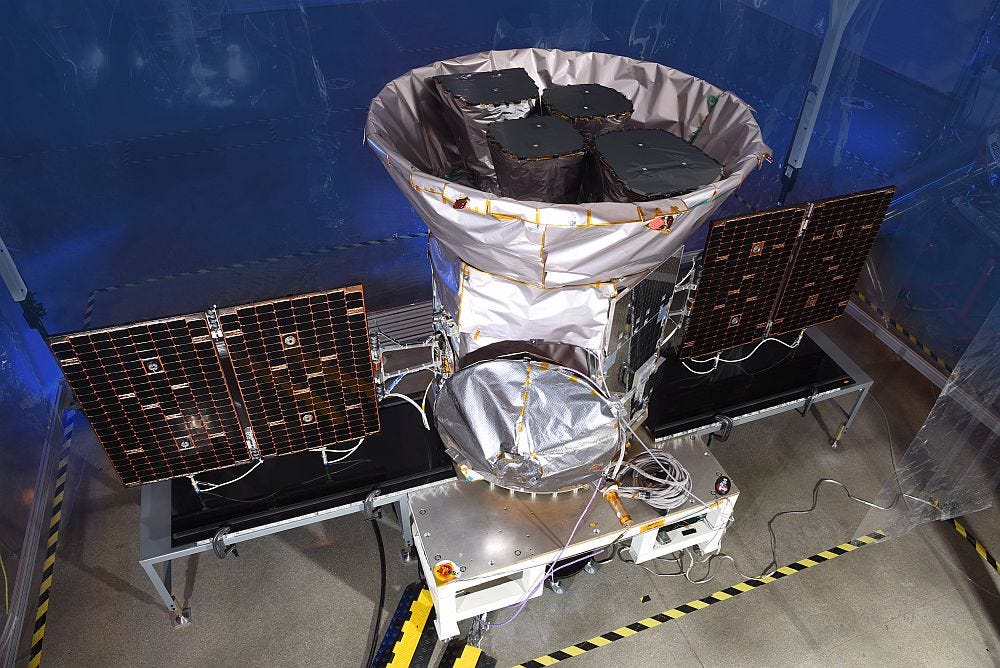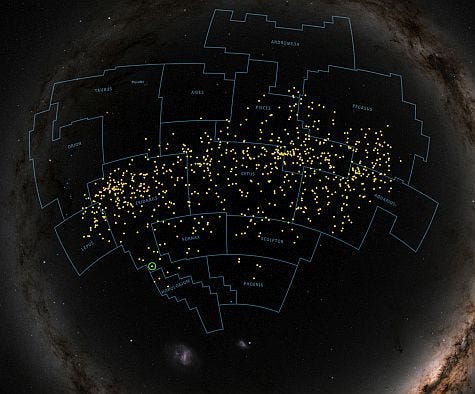Roughly 400 light years from Earth, a young star named TOI 451 travels within a river of stars. An international team of astronomers has now found three previously unknown exoplanets orbiting that star.
The Pisces-Eridanus stream of stars was only recently discovered — at the end of 2018 — despite stretching across one-third of the sky. Stars within this stream average only around 3% of the age of our own solar system.
“This system checks a lot of boxes for astronomers. It’s only 120 million years old and just 400 light-years away, allowing detailed observations of this young planetary system. And because there are three planets between two and four times Earth’s size, they make especially promising targets for testing theories about how planetary atmospheres evolve,” explains Dr. Elisabeth Newton of Dartmouth College.
My three planets
This trio of exoplanets was first spotted in data collected from the Transiting Exoplanet Survey Satellite (TESS) space telescope, launched in 2018. This telescope, designed to study the entire sky, locates exoplanets as they transit, or pass “in front of” their star, as seen from Earth.
Through 2019 and 2020, the sights of the infrared Spitzer Space Telescope were set toward the TOI 451 system, conducting follow-up studies of these alien worlds. Spitzer was powered down at the start of 2020, forever ending its mission exploring the skies in infrared wavelengths.
Additional archival data was obtained from observations of the star taken from 2009 to 2011 by NASA’s Near-Earth Object Wide-Field Infrared Survey Explorer (NEOWISE) satellite.
[Read: ]
The innermost of these newly-discovered planets is slightly less than twice the diameter of the Earth, and revolves around TOI 451 once every 46 hours. The middle world is more than three times as large as the Earth, and its year lasts a little over nine days. The outermost of these newly-discovered exoplanets, just over four times the size of our homeworld, circles TOI-451 once every 16 days.
These exoplanets orbit much closer to their star than the planets of our solar system keep from the Sun. The outermost of these world huddles its parent star at just one-third of the distance between Mercury and the Sun.
This proximity to the nuclear furnace of TOI 451 results in scorching temperatures on these alien worlds. The innermost world, TOI 451 b, is thought to have surface temperatures around 1.200 C (2,200 F). At the outskirts of this system, TOI 451 d sports surface temperatures around 450 C (840 F).
While smaller planets would quickly lose their atmosphere to pressure from the star, the significant mass of these worlds is likely to hold onto atmospheres, researchers speculate.
You’re a star!
“The sun and its retinue of planets drift as a group through the vast gulfs of space that separate the stars.” — Barney Oliver
The star TOI 451 is thought to have a pair of stellar companions, orbiting far beyond the orbits of the newly-discovered planets.
“The sun in this planetary system is very similar to our own sun but much younger. By studying these planets in the context of others, we can piece together the picture of how planets form and develop,” Newton states.
Stellar streams like the one housing TOI 451 form as clusters of stars or small dwarf galaxies are torn apart by gravitational forces, stretching out the members of the group like a peloton of stars, continuing to race along their original trajectory. Eventually, these streams disperse, spreading their stars around space.
The Pisces-Eridanus stream currently stretches 1,300 light years in length. From Earth, it appears to stretch across 14 constellations. This stellar river is also older than astronomers originally believed, this new study reveals.
Dwarf stars in the stream… that is what we are…
In 2019, a team of researchers led by Jason Curtis at Columbia University examined dozens of members of the stream seen by TESS.
Younger stars tend to rotate more quickly, and show darker sunspots than older counterparts. Astronomers are able to see these dark paths as they rotate around their star, revealing the rotational rates of these stellar bodies.
This study showed that the stars — and thus the stream itself — is only about 120 million years old — just 12.5 percent of the age previously calculated. This significantly-younger estimate was also in line with measurements of lithium and excess ultraviolet light from the stars.
While the first planet in a solar system like our own was only discovered in 1995, astronomers currently know of 4,400 planets orbiting other stars. Still, the TOI 451 system is just the eighth young planetary system found where planets can be seen transiting in front of their star.
In the video below, take a look at another exciting planetary system — TRAPPIST-1 — with Dr. Eric Agol. (Video credit: The Cosmic Companion)
[embedded content]
Newton and her team also found evidence of a possible disk of debris in the TOI 451 system. This loose rocky ring likely orbits at about the distance Jupiter keeps from the Sun. Researchers believe it to be similar to the asteroid belt in our solar system, but dustier and more disperse.
Following the launch of the James Webb Space Telescope, astronomers will be able to study the atmospheres of exoplanets in far-greater detail than is possible today, even using the Hubble Space Telescope.
“The planets offer excellent prospects for transmission spectroscopy with the Hubble Space Telescope and the James Webb Space Telescope, providing the opportunity to study planetary atmospheres that may still be in the process of evolving,” researchers describe in The Astronomical Journal.
Astronomy is now entering an exciting new era, as we learn the details of worlds in distant star systems for the first time.
This article was originally published on The Cosmic Companion by James Maynard, founder and publisher of The Cosmic Companion. He is a New England native turned desert rat in Tucson, where he lives with his lovely wife, Nicole, and Max the Cat. You can read this original piece here.
Astronomy News with The Cosmic Companion is also available as a weekly podcast, carried on all major podcast providers. Tune in every Tuesday for updates on the latest astronomy news, and interviews with astronomers and other researchers working to uncover the nature of the Universe.



